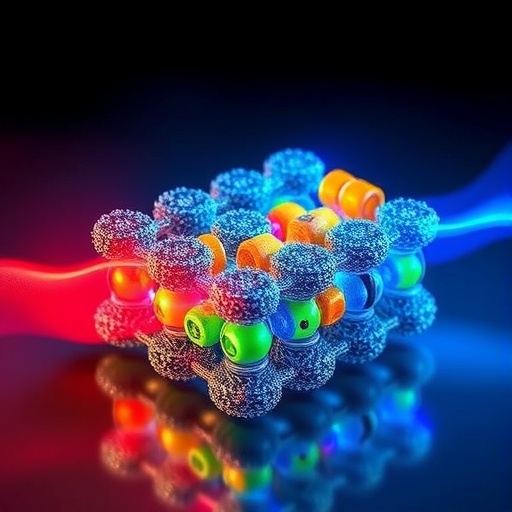In the ever-evolving domain of energy storage technologies, researchers are continually striving to enhance the efficiency and performance of devices such as supercapacitors. The latest study conducted by Ganesh Babu and his team introduces a groundbreaking approach to supercapacitor design through the innovative integration of multi-walled carbon nanotubes (MWCNTs) with manganese ferrite (MnFe₂O₄) and molybdenum disulfide (MoS₂). This composite electrode is presented as a game-changer in the field of asymmetric supercapacitors, promising superior energy storage capabilities and performance metrics.
As supercapacitors gain traction in applications ranging from electric vehicles to renewable energy systems, the quest for materials that exhibit not only high conductivity but also excellent electrochemical stability has become more critical than ever. The incorporation of MWCNTs into the MnFe₂O₄/MoS₂ composite is a strategic choice that capitalizes on the unique properties of each component. MWCNTs are known for their remarkable electrical conductivity and mechanical strength, which can significantly enhance the overall performance of the resulting composite material.
The unique partnership between manganese ferrite and molybdenum disulfide in this research underscores the potential of transitioning traditional electrode materials into high-performing alternatives. MnFe₂O₄, a mixed metal oxide, has garnered significant attention thanks to its abundant availability, low cost, and inherent electrochemical properties, including excellent charge storage capacity and cyclic stability. When combined with MoS₂, a layered transition metal dichalcogenide, the resulting framework shows promise in facilitating ion and electron transport during charge and discharge cycles, thus amplifying the energy density.
The methodology employed in the synthesis of the MWCNT-decorated MnFe₂O₄/MoS₂ composite showcases advanced nanotechnology techniques that ensure uniform distribution and optimal interaction between the components. The innovative technique not only enhances the electrical conductivity but also promotes faster ion diffusion, a crucial factor for improving charge-discharge rates in supercapacitors. The synergy created by this composite structure allows for a compact energy storage solution that meets the increasing demands for energy management in modern technology.
Further investigation into the electrochemical performance of this new composite electrode reveals impressive results. The researchers conducted a series of tests to evaluate important performance metrics such as specific capacitance, energy density, and power density. The findings indicate that the use of the MWCNT-decorated composite significantly outperforms conventional electrode materials under similar testing conditions. This advance illustrates how strategic material engineering can lead to substantial improvements in energy storage devices.
Moreover, the study outlines the stability of the synthesized composite, with the MWCNTs serving as a protective scaffold that retains the structural integrity of the MnFe₂O₄ and MoS₂ during operation. This resilience is essential for commercial supercapacitors, which are subject to numerous charge-discharge cycles throughout their lifespan. The researchers reported that the composite retained its performance metrics even after extensive cycling, suggesting a long-term viability necessary for practical applications.
As the world increasingly pivots toward sustainable energy solutions, high-performance devices such as the MWCNT-decorated MnFe₂O₄/MoS₂ asymmetric supercapacitor exhibit the potential to play a pivotal role in this transition. By providing solutions that not only meet the efficiency needs of contemporary applications but also support the scalability required for commercial production, this research lays the groundwork for future developments in energy storage technologies.
The integration of advanced materials like MWCNTs and transition metal dichalcogenides into the field of asymmetric supercapacitors demonstrates not only a scientific achievement but also reflects a commitment to addressing global energy challenges. As technology progresses, the demand for sustainable and efficient energy storage solutions will continue to rise. The advancements made in the realm of composite electrodes pave the way for innovations that could redefine how energy is stored and utilized in various sectors.
The authors acknowledge that their work represents just a starting point. Future research may involve exploring alternative materials or further optimizing the composite structure to enhance both performance and manufacturing processes. Additionally, adapting these findings to suit different environmental conditions and application requirements will be crucial for translating laboratory successes into real-world solutions.
The implications of this study extend beyond enhanced performance; they could revolutionize the market dynamics surrounding energy storage technology. As various industries weigh the benefits of adopting high-efficiency supercapacitors in place of traditional batteries, the introduction of composites like the one studied could lead to decreased reliance on less sustainable methods of energy storage.
In conclusion, the synergistic integration of MWCNTs, MnFe₂O₄, and MoS₂ signifies a formidable strategy in the advancement of supercapacitor technology. This research not only highlights the potential for improved energy storage but also invites further exploration into the combination of diverse materials to solve complex technological challenges. The journey towards optimal energy solutions is ongoing, but studies like this one illuminate the path forward, revealing limitless possibilities on the horizon.
The future of energy storage looks promising as we move closer to realizing advanced materials capable of powering the technologies that define modern life. Researchers continue to push boundaries and innovate, ensuring that as our energy demands evolve, so too do our methods for meeting them.
Subject of Research: Integration of MWCNT-decorated MnFe₂O₄/MoS₂ composite electrode for asymmetric supercapacitors.
Article Title: Synergistic integration of MWCNT-decorated MnFe₂O₄/MoS₂ composite electrode for high-performance asymmetric supercapacitors.
Article References:
Ganesh Babu, L., Prasanth, P., Selvi, C.T. et al. Synergistic integration of MWCNT-decorated MnFe2O4/MoS2 composite electrode for high-performance asymmetric supercapacitors. Ionics (2025). https://doi.org/10.1007/s11581-025-06809-w
Image Credits: AI Generated
DOI: https://doi.org/10.1007/s11581-025-06809-w
Keywords: Supercapacitors, MWCNT, MnFe₂O₄, MoS₂, Composite Electrode, Energy Storage, Asymmetric Supercapacitors.
Tags: advanced electrode materialsasymmetric supercapacitor designelectric vehicle energy systemselectrochemical stability in supercapacitorsenergy storage performance enhancementhigh conductivity materialsinnovative energy storage technologiesmanganese ferrite compositesmolybdenum disulfide applicationsmulti-walled carbon nanotubesrenewable energy storage solutionssupercapacitor technology





